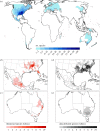Multiple drivers of decline in the global status of freshwater crayfish (Decapoda: Astacidea)
- PMID: 25561679
- PMCID: PMC4290432
- DOI: 10.1098/rstb.2014.0060
Multiple drivers of decline in the global status of freshwater crayfish (Decapoda: Astacidea)
Abstract
Rates of biodiversity loss are higher in freshwater ecosystems than in most terrestrial or marine ecosystems, making freshwater conservation a priority. However, prioritization methods are impeded by insufficient knowledge on the distribution and conservation status of freshwater taxa, particularly invertebrates. We evaluated the extinction risk of the world's 590 freshwater crayfish species using the IUCN Categories and Criteria and found 32% of all species are threatened with extinction. The level of extinction risk differed between families, with proportionally more threatened species in the Parastacidae and Astacidae than in the Cambaridae. Four described species were Extinct and 21% were assessed as Data Deficient. There was geographical variation in the dominant threats affecting the main centres of crayfish diversity. The majority of threatened US and Mexican species face threats associated with urban development, pollution, damming and water management. Conversely, the majority of Australian threatened species are affected by climate change, harvesting, agriculture and invasive species. Only a small proportion of crayfish are found within the boundaries of protected areas, suggesting that alternative means of long-term protection will be required. Our study highlights many of the significant challenges yet to come for freshwater biodiversity unless conservation planning shifts from a reactive to proactive approach.
Keywords: IUCN Red List; crayfish; extinction risk; freshwater biodiversity; threatened.
Figures


Similar articles
-
Combined effects of life-history traits and human impact on extinction risk of freshwater megafauna.Conserv Biol. 2021 Apr;35(2):643-653. doi: 10.1111/cobi.13590. Epub 2020 Oct 8. Conserv Biol. 2021. PMID: 32671869
-
Extinction risk of the world's freshwater mammals.Conserv Biol. 2024 Feb;38(1):e14168. doi: 10.1111/cobi.14168. Epub 2023 Nov 3. Conserv Biol. 2024. PMID: 37563953 Review.
-
Diversity, distribution and extinction risk of native freshwater fishes of South Africa.J Fish Biol. 2022 Apr;100(4):1044-1061. doi: 10.1111/jfb.15011. Epub 2022 Mar 19. J Fish Biol. 2022. PMID: 35170047
-
One-quarter of freshwater fauna threatened with extinction.Nature. 2025 Feb;638(8049):138-145. doi: 10.1038/s41586-024-08375-z. Epub 2025 Jan 8. Nature. 2025. PMID: 39779863 Free PMC article.
-
Freshwater biodiversity: importance, threats, status and conservation challenges.Biol Rev Camb Philos Soc. 2006 May;81(2):163-82. doi: 10.1017/S1464793105006950. Epub 2005 Dec 12. Biol Rev Camb Philos Soc. 2006. PMID: 16336747 Review.
Cited by
-
A synthetic phylogeny of freshwater crayfish: insights for conservation.Philos Trans R Soc Lond B Biol Sci. 2015 Feb 19;370(1662):20140009. doi: 10.1098/rstb.2014.0009. Philos Trans R Soc Lond B Biol Sci. 2015. PMID: 25561670 Free PMC article.
-
The significance of droughts for hyporheic dwellers: evidence from freshwater crayfish.Sci Rep. 2016 May 26;6:26569. doi: 10.1038/srep26569. Sci Rep. 2016. PMID: 27225308 Free PMC article.
-
A new species of Procambarus (Decapoda, Cambaridae) from the State of Querétaro, Mexico.Zookeys. 2021 Jul 6;1048:1-21. doi: 10.3897/zookeys.1048.57493. eCollection 2021. Zookeys. 2021. PMID: 34295214 Free PMC article.
-
Distribution and evidence of co-infection of the two microsporidian parasites Astathelohania contejeani and Nosema austropotamobii in Austropotamobius pallipes complex in Northern and Central Italy.Parasitology. 2024 Dec;151(14):1587-1596. doi: 10.1017/S0031182024001525. Parasitology. 2024. PMID: 39567840 Free PMC article.
-
Assessing threats of non-native species to native freshwater biodiversity: Conservation priorities for the United States.Biol Conserv. 2018 Aug;224:199-208. doi: 10.1016/j.biocon.2018.05.019. Biol Conserv. 2018. PMID: 30245526 Free PMC article.
References
-
- Strayer D, Dudgeon D. 2010. Freshwater biodiversity conservation: recent progress and future challenges. J. N. Am. Benthol. Soc. BioOne 29, 344–358. (10.1899/08-171.1) - DOI
-
- Darwall WRT, et al. 2011. Implications of bias in conservation research and investment for freshwater species. Conserv. Lett. 4, 474–482. (10.1111/j.1755-263X.2011.00202.x) - DOI
-
- Holland RA, Darwall WRT, Smith KG. 2012. Conservation priorities for freshwater biodiversity: the key biodiversity area approach refined and tested for continental Africa. Biol. Conserv. 148, 167–179. (10.1016/j.biocon.2012.01.016) - DOI
-
- Cumberlidge N, et al. 2009. Freshwater crabs and the biodiversity crisis: Importance, threats, status, and conservation challenges. Biol. Conserv. 142, 1665–1673. (10.1016/j.biocon.2009.02.038) - DOI
Publication types
MeSH terms
LinkOut - more resources
Full Text Sources
Other Literature Sources

